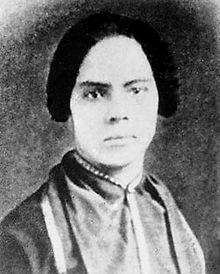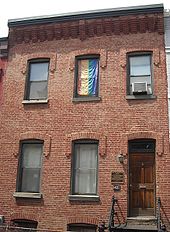- Mary Ann Shadd
-
Mary Ann Shadd Cary (October 9, 1823 – June 5, 1893) was born to Abraham and Harriett Shadd, both free-born blacks, in Wilmington, Delaware. She was the oldest in her family of 13 children. Her father, a shoemaker, was a key figure in the Underground Railroad and a subscription agent for William Lloyd Garrison's abolitionist newspaper, The Liberator.
When she was ten, Mary Ann and her family moved from their home in Delaware to West Chester, Pennsylvania, so the children could get an education at a Quaker-run school where she was educated for the next six years before moving back to Wilmington.
In 1840, Shadd returned to West Chester and established a school for black children. She also taught in Norristown, Pennsylvania and New York City.
Contents
Social activism
When the Fugitive Slave Law of 1850 in the United States threatened to return free northern blacks and escaped slaves to bondage, Shadd and her brother Isaac moved to Canada and settled in Windsor, Ontario. In Windsor, she founded a racially integrated school with the support of the American Missionary Association. Shadd's support for racial integration embroiled her in a public dispute with Henry Bibb, the established leader in the black community in Canada. Bibb's newspaper, The Voice of the Fugitive, attacked Shadd's ideas and character, leading Shadd to found The Provincial Freeman newspaper in 1853, along with Samuel Ringgold Ward. The paper quickly folded, but Shadd and Ward revived it a year later from an office in King Street, Toronto. The paper continued to be published until 1859 promoting temperance, moral reform, civil rights and black self-help while attacking the racial discrimination blacks faced within North America. It was one of the longest published black newspapers until the Civil War.
Shadd believed that separate churches, schools and communities for blacks would ultimately undermine the search for freedom. She campaigned for equality and integration for black people, making public speeches and addressing issues of abolition and other reforms. Eventually, many of her family members, including her father and sisters, joined her in Canada.
In 1856, she married Thomas F. Cary, a barber from Toronto who was involved with the newspaper. They had two children, Sarah and Linton, and lived in Chatham, Ontario, where she continued to work on her newspaper and teach school. In 1858, John Brown held a secret "convention" at the home of her brother Isaac. In 1861, she published Voice from Harper's Ferry, a tribute to Brown's unsuccessful raid.
Civil War and postbellum activism
After her husband died in 1860, Shadd Cary and her children returned to the United States. During the Civil War, she served as a recruiting officer to enlist black volunteers for the Union Army in the state of Indiana. After the Civil War, she taught in black schools in Wilmington, before moving to Washington, D.C., where she taught in public schools and attended Howard University School of Law. She graduated as a lawyer in 1883, becoming only the second black woman in the United States to earn a law degree. She wrote for the newspapers National Era and The People's Advocate.
Shadd Cary joined the National Woman Suffrage Association, working alongside Susan B. Anthony and Elizabeth Cady Stanton for women's suffrage, testifying before the Judiciary Committee of the House of Representatives and becoming the first black woman to cast a vote in a national election.
She died in Washington, D.C. on June 5, 1893. Shadd's former residence in the U Street Corridor was declared a National Historic Landmark in 1976. In 1987 she was designated a Women's History Month Honoree by the National Women's History Project.[1]
See also
References
- ^ "Honorees: 2010 National Women’s History Month". Women's History Month. National Women's History Project. 2010. http://nwhp.org/whm/honorees.php. Retrieved 14 November 2011.
- Beardon, Jim and Butler, Linda Jean, Shadd: the Life and times of Mary Shadd Cary. Toronto: NC Press Ltd., 1977.
- Rhodes, Jane, Mary Ann Shadd Cary: the Black Press and Protest in the Nineteenth Century. Bloomington: Indiana University Press, 1998.
External links
Categories:- 1823 births
- 1893 deaths
- 19th-century American newspaper publishers (people)
- 19th-century newspaper publishers (people)
- Canadian newspaper publishers (people)
- African American educators
- African American writers
- American abolitionists
- American female lawyers
- American feminists
- American newspaper founders
- American suffragists
- Black Canadian writers
- Howard University School of Law alumni
- National Historic Persons of Canada
- People from Wilmington, Delaware
- Washington, D.C. lawyers
- Women in the American Civil War
- Writers from Washington, D.C.
Wikimedia Foundation. 2010.


